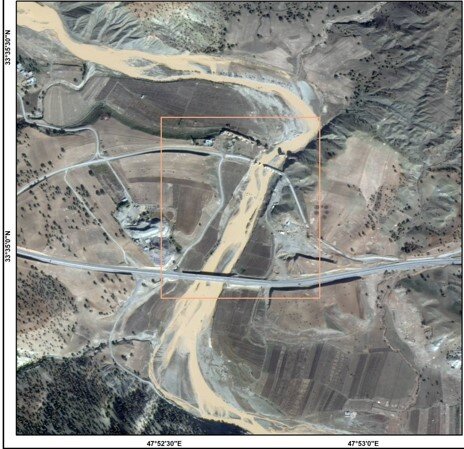"Khayyam" satellite captures images of flood-hit areas

TEHRAN – The homegrown "Khayyam" satellite has captured images from flood-hit regions in the west and southwest of the country.
The satellite was sent into orbit back in August of last year from the Baikonur Cosmodrome in Kazakhstan, which is run by Moscow.
Based on the Iranian Space Agency (ISA), the satellite employs remote sensing capabilities to provide high-quality images four times per day for use in environmental and agricultural studies as well as water resource monitoring.
Tens of locations in the vicinity of rivers in the western province of Lorestan and the southwestern province of Khuzestan have been assessed before and after rainfalls that led to floods, Mehr reported.
The satellite is also capable of monitoring forest areas and can immediately track wildfires, Reza Bayani an official with Forests, Range, and Watershed Management Organization, has said.
Improving productivity in the agriculture sector, surveying water resources, managing natural disasters, confronting deforestation, monitoring border areas and mining explorations are among the main objectives of the satellite.
If a fire occurs in an area during the satellite's rotation, we can record its images at the same moment, and the positive and significant point of this satellite is that its images are periodic, he stated.
In many parts of the world, when some satellites record an image, a certain period of time passes until the next image is recorded, and in most parts of the world, images are sent with a time interval of 15 to 20 days, and during this interval, they use other satellites, but we can use Khayyam in different periods to monitor different areas of the country and have periodic information, he explained.
Extracting periodic information from the earth is the most widely used function of this satellite for systems such as natural resources, agriculture, and geology to use the earth's platform to be up-to-date at any moment, according to Bayani.
Having a satellite with this resolving power can monitor the borders of the country, changes in vegetation, changes in forests, changes in the boundaries of cities and mines, and how to harvest them, he said.
It can level the type of agricultural products and their quantity and quality in agricultural lands, in addition to monitoring the type of forest species using its data. During a fire, it shows the critical areas and how the vegetation will return to the burnt lands, he concluded.
Hossein Daliriyan, a spokesperson for the Iranian Space Agency, said in June that the Khayyam satellite takes images from different parts of the country.
“These images will be utilized in order to address legal challenges of ordinary people and state institutions concerning land use changes.”
“We are ready to offer necessary data to other Iranian state agencies and help them solve their problems in various fields, including environmental monitoring, water resources, soil erosion and land subsidence,” he added.
Despite U.S. sanctions, Iran has made enormous technological and scientific advancements.
In June, ISA revealed that preparations were being made to launch seven additional satellites into orbit.
Iran conducted a second test of its homegrown Zuljanah hybrid-propellant satellite carrier rocket in late June for "predetermined research purposes." In February 2021, the Zuljanah satellite carrier was first launched into orbit by the Defense Ministry.
President Ebrahim Raisi has emphasized the need to continue efforts to enhance space technology.
He stated in mid-March that “the obtainment of this technology is among the manifestations of national might, which was made possible with the efforts of the Armed Forces - especially the Islamic Revolution Guards Corps and the Communications Ministry - and must continue with greater force.”
President Raisi also highlighted the government's serious commitment to advancing space technology.
MG
Leave a Comment